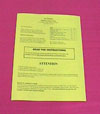Make a Battery from Potato
Introduction:Batteries generate electricity through a chemical reaction between two different electrodes and one electrolyte. Use of Copper and Zinc electrodes and Sulfuric acid as electrolyte is a proven method for this process. We are wondering if we can use any other liquid as electrolyte? This gave us the idea of using a potato as electrolyte. After all a fresh potato has a lot of juice that may serve our purpose as electrolyte.
Problem:
Can Potato be used to generate electricity?
Hypothesis:
Potato juice contains many water soluble chemicals that may cause a chemical reaction with one or both of our electrodes. So we may get some electricity from that.
| Material: For this experiment we use:
|  |
We insert copper and zinc electrodes in to the potato, close but not touching each other. We use Clip leads to connect our electrodes to the Multimeter to measure voltage between two electrodes or current passing through the multimeter. For this experiment we removed the shell of a broken AA battery for our Zinc electrode. (Make sure to test your multimeter by connecting its Positive and Negative wires to each other that should show no current and no voltage).
Record And Analyze Data: | A digital multimeter showed 1.2 volts between the electrodes, but the analog multimeter showed a much smaller value. In other words even though the voltage between electrodes is 1.2 Volts, the speed of production of electricity is not high enough for an analog multimeter to show the exact voltage. (Analog multimeter gets its power from our potato to show the voltage, but digital Multimeter gets its power from an internal battery and does not consume any of the electricity produced by our potato, that is why it shows a larger and more accurate value). We repeated this experiment with some other fruits and all resulted almost the same. In all cases the produced voltage is between 1 and 1.5 volts, and in all cases they do not produce enough current to turn on a small light. | |||
Another thing that we learned from this experiment is that creating electricity and making a battery is easy, the main challenge is producing a battery that can continue to produce larger amount of electricity for larger amount of time.
| ||||
| ||||||||||||||










